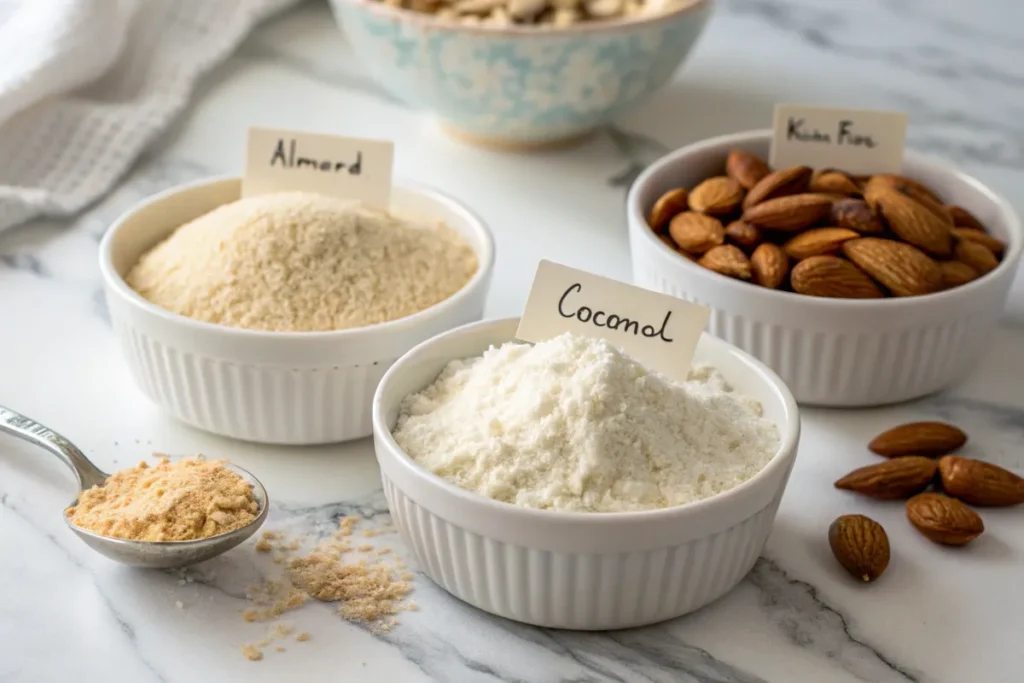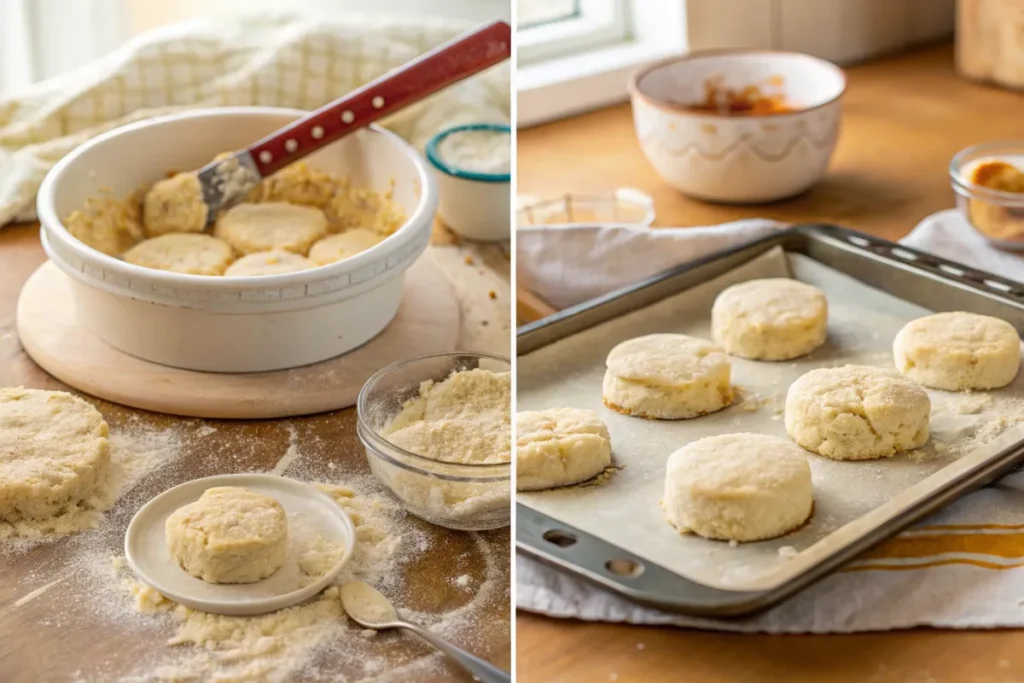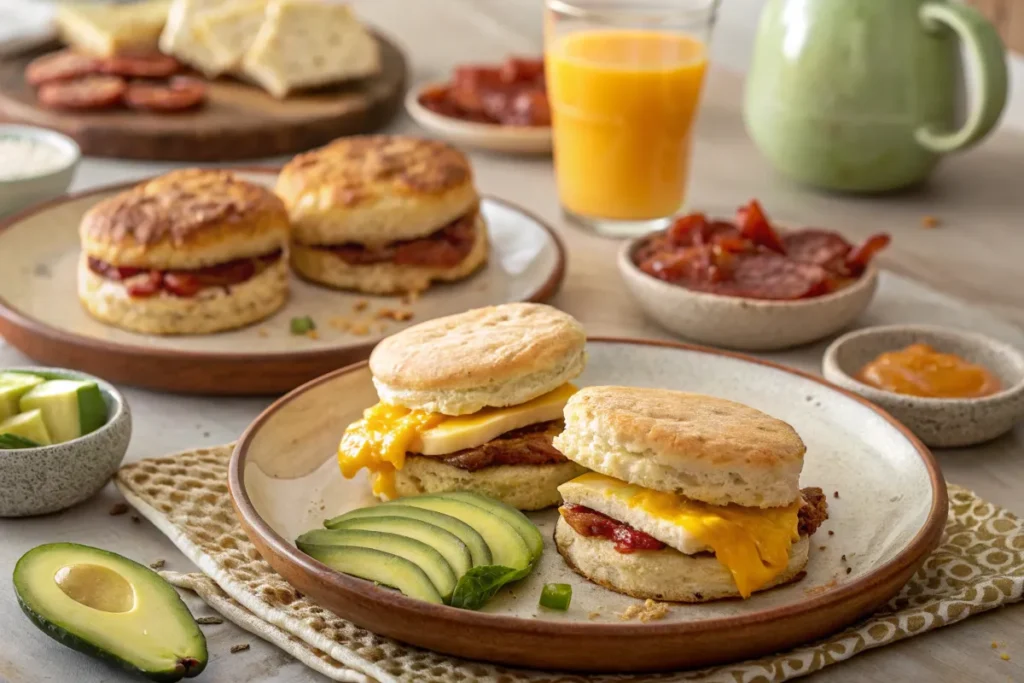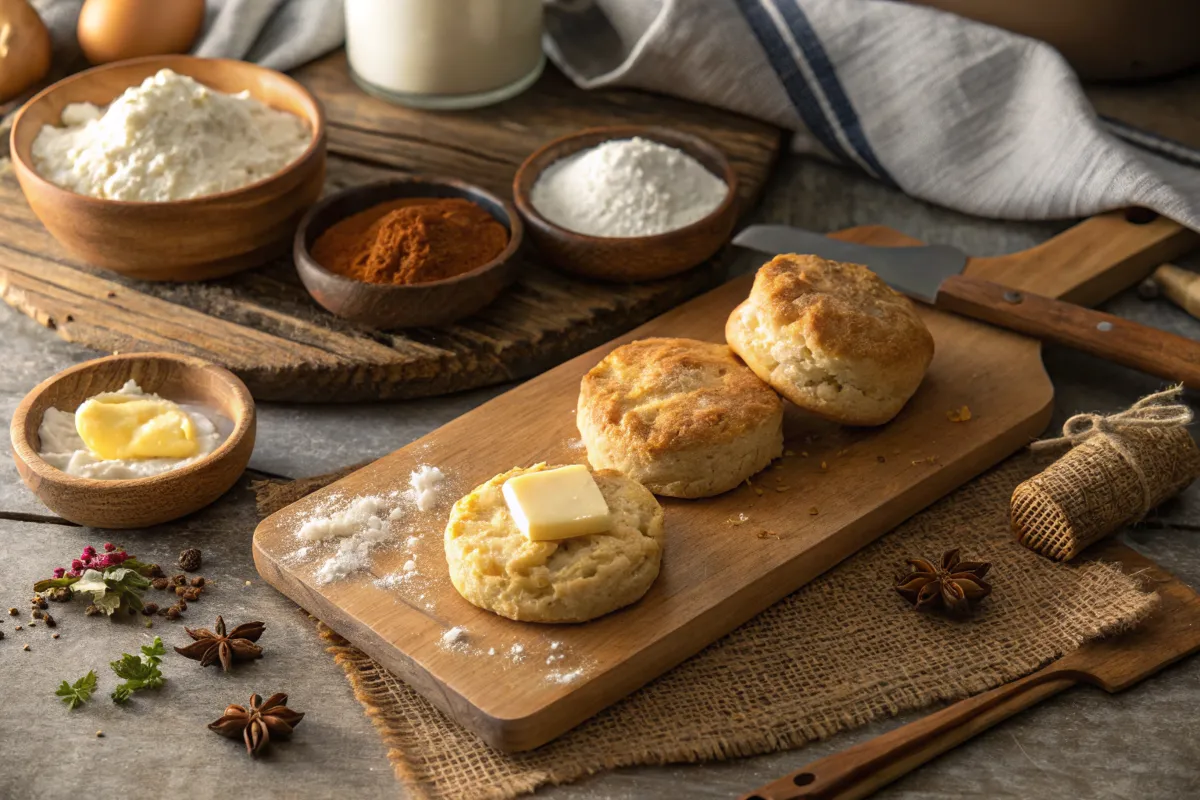Introduction
Craving a soft, flaky biscuit but can’t tolerate gluten? You’re not alone. More and more people are searching for the perfect gluten free biscuit recipe—one that doesn’t crumble, taste dry, or feel like cardboard. Whether you’re gluten-intolerant, have celiac disease, or simply want to cut back on wheat, there’s good news: you don’t have to give up warm, buttery biscuits.
This guide is packed with helpful tips, ingredient swaps, troubleshooting tricks, and, of course, delicious variations of the ultimate gluten free biscuit recipe. From dairy-free options to make-ahead freezer tricks, you’ll learn everything you need to master biscuits without the gluten. We’ll also answer popular questions like why gluten-free dough behaves differently, and which flour blends deliver the best rise and texture.
So grab your apron and let’s get baking—it’s time to bring soft, golden biscuits back to your breakfast (or dinner!) table.
Why Go Gluten-Free with Your Biscuits?
Understanding Gluten Sensitivity and Celiac Disease
Gluten is a protein found in wheat, barley, and rye. For people with celiac disease or non-celiac gluten sensitivity, eating gluten can lead to digestive issues, fatigue, and inflammation. That’s where a solid gluten free biscuit recipe becomes essential—not just for health, but also for comfort.
Let’s be honest: biscuits are more than just food—they’re a feeling. Warm, buttery, flaky layers can turn any meal into something special. But if you’re avoiding gluten, traditional biscuit recipes are off the table. Luckily, with the right ingredients, you can still enjoy that same comfort without the gluten.
The Rise of Gluten-Free Comfort Foods
In recent years, gluten-free baking has evolved in big ways. Gone are the days of dense, dry, and flavorless alternatives. Today’s gluten free biscuit recipes offer all the fluff and tenderness of the originals, often without anyone realizing they’re gluten-free at all.
Whether you’re cooking for dietary needs or just trying something new, gluten-free biscuits are a great place to start. They’re quick to make, versatile, and surprisingly forgiving—perfect for beginners and pros alike.
By the end of this guide, you’ll have more than just one great recipe—you’ll have a full toolkit for baking fluffy, golden biscuits that everyone will love.
Ingredients and Substitutions for a Perfect Gluten Free Biscuit Recipe

Key Gluten-Free Flours to Use
When baking a gluten free biscuit recipe, choosing the right flour blend is essential. Common options include almond flour, rice flour, coconut flour, or store-bought gluten-free all-purpose flour blends. Each flour has its unique texture and taste—so finding the right balance is key. For example, almond flour adds a rich, nutty flavor, while rice flour keeps things light and fluffy.
Most recipes combine these with starches like tapioca or potato starch to improve structure. Many home bakers also add a binding agent like xanthan gum or psyllium husk to mimic the elasticity of gluten. Without these, your biscuits might crumble easily or fail to rise.
To explore more baking techniques for fragile doughs, you can also refer to why does my cottage cheese flatbread fall apart all — this article gives great troubleshooting tips that apply to gluten-free bakes too.
Dairy-Free and Egg-Free Variations
If you’re also avoiding dairy or eggs, worry not. Substituting butter with vegan margarine or coconut oil works well. Use cold, solid fats to help create layers in your biscuits. For eggs, try using chia eggs (1 tbsp chia + 3 tbsp water) or flax eggs as a binder.
Even your buttermilk can be replaced with a mixture of almond milk and lemon juice. This tangy liquid still activates baking soda just like traditional buttermilk does.
Step-by-Step Instructions to Make the Best Gluten Free Biscuit Recipe
Mixing the Dough Correctly
Start by whisking your dry ingredients together—your gluten-free flour, baking powder, salt, and xanthan gum. Then, cut in your cold fat using a pastry cutter or two forks. This step is vital: you want pea-sized pieces of butter or margarine throughout the flour, which melt during baking and create flaky layers.
Next, gently stir in the buttermilk until just combined. Don’t overmix the dough—this can make it tough and dense.
Shaping and Baking Tips

Once your dough is ready, turn it out onto a floured surface. Pat it into a rectangle about an inch thick. Fold the dough over itself a few times to add flakiness, then cut into circles using a biscuit cutter or even a floured glass.
Preheat your oven to 425°F (220°C). Place biscuits close together on a parchment-lined baking sheet. This allows them to support each other and rise taller.
Bake for 12–15 minutes or until golden brown. For an extra golden crust, brush the tops with a little milk or melted butter before baking.
If you enjoy hearty breakfast options, you might also like this protein pudding recipe, which makes a great side to pair with your warm biscuits.
If you’re looking for a tested alternative to try or compare, check out this gluten-free biscuit recipe by King Arthur Baking. It’s a go-to among gluten-free bakers for its consistent rise and flavor.
Common Mistakes When Making a Gluten Free Biscuit Recipe
Overmixing or Underhydrating the Dough
One of the biggest pitfalls in preparing a gluten free biscuit recipe is overmixing the dough. Unlike regular flour, gluten-free blends don’t have the elasticity to bounce back from too much handling. As a result, the dough can quickly become gummy and unworkable.
Another mistake? Not adding enough liquid. Gluten-free flours absorb more moisture than wheat flour. If your biscuit dough feels dry or crumbly, add more buttermilk one tablespoon at a time until the texture feels slightly sticky but not wet.
Using the Wrong Flour Blend or Skipping the Binder
Not all gluten-free flours are created equal. If you’re using a single flour like coconut or oat flour without balancing it with starch or xanthan gum, your biscuits will likely crumble apart or fail to rise. That’s why using a tested blend specifically for baking is crucial.
To see another recipe where ingredient choice greatly affects texture, check out this cottage cheese flatbread tutorial. The same principles apply when baking gluten-free!
Storage and Reheating Tips for Gluten Free Biscuits
How to Store Freshly Baked Biscuits
Once your gluten free biscuits are baked and cooled, store them in an airtight container. At room temperature, they’ll stay fresh for up to 2 days. For longer storage, pop them into the fridge, where they’ll keep for up to a week.
If you want to store them even longer, wrap them tightly in plastic and freeze for up to 3 months. Just be sure to label them with the date!
Best Ways to Reheat Without Drying Out
No one wants a dry biscuit. To reheat your gluten free biscuit recipe leftovers, wrap them in foil and place them in a 300°F (150°C) oven for about 10 minutes. This gently warms the biscuit without drying it out.
Alternatively, you can microwave it for 10–15 seconds, but place a damp paper towel over it to trap steam and retain moisture.
Pro Tip: Add a pat of butter right after reheating to restore that fresh-from-the-oven feel.
How to Store and Reheat Gluten Free Biscuits
Keep Your Gluten Free Biscuits Fresh Longer
You’ve made a delicious batch of biscuits—now what? First, let them cool completely. Warm biscuits stored too early can turn soggy. Once cooled, transfer them to an airtight container and store at room temperature for up to two days.
Want to extend their life? No problem. Refrigerate your gluten free biscuit recipe leftovers for up to a week. Be sure to wrap them tightly to avoid drying out. For even longer storage, freeze them! Wrap each biscuit individually and place them in a freezer bag. This way, you can grab one anytime without defrosting the whole batch.
How to Reheat Without Losing Moisture
Reheating biscuits is tricky—you want them warm and soft, not hard and dry. The oven is your friend here. Wrap the biscuits in foil and warm them at 300°F (150°C) for 10–12 minutes.
In a hurry? Use the microwave, but cover the biscuit with a damp paper towel. Heat for 15–20 seconds to restore that fresh-baked feel. Want to level up the flavor? Brush a little melted butter on top after reheating—it brings back the richness of your original gluten free biscuit recipe.
Serving Ideas and Meal Pairings for Your Gluten Free Biscuit Recipe

Breakfast, Brunch, and Beyond
Biscuits aren’t just for breakfast anymore. A good gluten free biscuit recipe can shine at any meal. In the morning, pair them with scrambled eggs, avocado, or fruit preserves. If you’re going savory, they’re perfect with sausage gravy or fried eggs.
For brunch, slice them and layer in your favorite fillings—think turkey and cranberry, egg and cheese, or even tomato and mozzarella. They work great as sliders, mini sandwiches, or on a breakfast charcuterie board.
Unexpected Ways to Use Gluten-Free Biscuits
Looking for creative ways to serve biscuits? Use them as a base for mini pot pies. Just hollow out the center and spoon in creamy chicken and veggies. Or crumble leftover biscuits over a casserole for a golden, crunchy topping.
You can also turn sweet versions of your gluten free biscuit recipe into shortcakes—just add whipped cream and berries. It’s a dessert-worthy upgrade that still feels homemade and wholesome.
FAQs – People Also Ask
What is the best flour for a gluten free biscuit recipe?
The best flour depends on your texture goals, but a blend of rice flour, potato starch, and tapioca starch often yields the fluffiest results. Store-bought gluten-free all-purpose blends also work well, especially those with xanthan gum included.
Why are my gluten-free biscuits dry or crumbly?
This is a common issue with any gluten free biscuit recipe. It usually means there wasn’t enough moisture or fat in your dough. Also, skipping binders like xanthan gum can prevent biscuits from holding together properly.
Can I make gluten free biscuits without xanthan gum?
Yes, you can. Substitute with psyllium husk, chia seed gel, or ground flaxseed to mimic the binding effect. These swaps also add a slight nutritional boost.
How do I make gluten free biscuits rise better?
Use fresh baking powder, avoid overmixing, and make sure your fat is cold when you mix the dough. Folding the dough gently helps create flaky layers that rise beautifully in the oven.
Final Thoughts + Printable Gluten Free Biscuit Recipe
Final Tips for Biscuit Success
There’s no magic wand when it comes to baking, but with the right tools and tricks, your gluten free biscuit recipe will turn out soft, golden, and satisfying. Always use cold fat, don’t overmix, and give your dough time to rest before baking. These simple steps can make all the difference.
And don’t be afraid to experiment. Whether you’re baking for dietary needs or pure comfort, gluten-free biscuits deserve a spot at every table.
Easy Gluten Free Biscuit Recipe (Printable Format)
Ingredients:
- 2 cups gluten-free all-purpose flour (with xanthan gum)
- 1 tbsp baking powder
- 1/2 tsp salt
- 1/2 cup cold butter or vegan alternative
- 3/4 cup buttermilk (or dairy-free milk + 1 tsp lemon juice)
Instructions:
- Preheat oven to 425°F (220°C).
- Whisk flour, baking powder, and salt.
- Cut in cold butter until mixture resembles coarse crumbs.
- Stir in buttermilk. Don’t overmix.
- Roll out, cut into biscuits, and bake 12–15 minutes.
Serve warm with butter, jam, or your favorite savory spread. You just made the perfect gluten free biscuit recipe—enjoy every bite!

